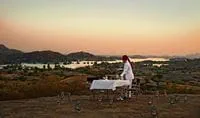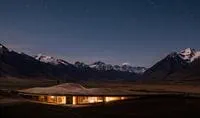Best Time to Visit Morocco
Morocco is a gem through the spring and fall seasons, but this destination is worthy of a tailor-made vacation all year round.
- Custom Morocco getaways during the best time of year
- Top-notch suggestions from award-winning travel specialists
- One-of-a-kind experiences for any month
- Round-the-clock support no matter the weather

Figuring out the best time to visit Morocco? It's like unlocking a secret door to a world bursting with color, spice, and everything nice. Think bustling souks in Marrakech, tranquil beaches in Essaouira, and the endless dunes of the Sahara. Spring (March to May) and fall (September to November) are your golden tickets. Not too hot, not too cold - just perfect. This is when you get the best time to travel to Morocco, with weather that plays nice for exploring medinas, haggling in markets, or catching a sunset over the desert.
It’s also ideal for winter sun, although January and February are the coldest months dropping to about 60°C at the lowest, while in the spring, you’ll find mid-70s to mid-80s depending on where you are. Read on for details on the best time to visit Morocco.
Monthly Climate Guide for Morocco
, Morocco
Average temperatures (Fahrenheit) and rainfall (mm)
Morocco's climate dances through the year, wearing a tapestry of temperatures and rainfall. From the crisp whispers of the Atlas Mountains to the warm embrace of the Sahara, each region tells its own story. Morocco finds its rhythm in spring, say March and April, and in autumn, around October and November. These months whisper tales of perfect days where the sun plays nice, and the rain rarely overstays its welcome. The weather in Morocco in November and October often gets applause for its mildness, making it a prime candidate for the best time to go to Morocco.
Summer, especially July and August, turns up the heat inland. Coastal breezes in cities like Essaouira offer a reprieve, making seaside escapes a summer delight. Yet, if you ask about the hottest months, the landlocked whispers fiercely of June through August.
For those seeking the best time to travel to Morocco, aiming for the shoulder seasons might just hit the sweet spot. Not only do these times offer a good time to visit Morocco, but they also dodge the high temperatures and the bulk of tourist crowds. Whether you're pondering Morocco in February's chill or September's gentle warmth, each season in Morocco opens the door to new adventures, making any time a good time to go—it all depends on what you're looking for.
Seasonal Highlights in Morocco
While Morocco has four seasons, they don’t differ too greatly from each other. Temperatures are at their highest in summer and lowest in winter, there is very little rainfall all year round, but you might see some snow in the winter.
The best time to visit Morocco is typically during spring and autumn, when comfortably warm temperatures are ideal for outdoor adventures and sightseeing.
The festive season in December in Morocco is a wonderful time to visit for sunshine and clear skies during the daytime, and cooler evenings. January and February are the coldest months and can be rainy, however, there are fewer visitors at this time of year, and hotels offer lower prices making it still a great option.
Another consideration is travel over the Islamic observance of Ramadan, which typically falls in March/April, but the date of this sacred month changes each year ask your travel expert about it when deciding if it’s the best time to see Morocco for you.
Best time to visit Morocco for…
Exploring Different Regions
When planning your Moroccan adventure, timing is everything. This diverse country offers a variety of experiences across its regions, each with its optimal visiting period. Whether you're drawn to the bustling medinas, serene coastal towns, or majestic mountains and deserts, knowing the best time to visit Morocco can significantly enhance your journey.
For city explorers, the charm of Morocco's key cities like Marrakesh, Fes, and Chefchaouen shines brightest in the shoulder seasons. Spring (March to May) and fall (September to November) are your best bets. These months avoid the scorching summer heat, offering mild temperatures ideal for wandering through ancient souks, exploring palaces, and enjoying rooftop dinners with views of sprawling medinas. Planning a trip that encompasses these cities in one go? Target April or October, when the weather is comfortably warm across the board, making them the best month to go to Morocco for city hopping.
For those drawn to the coast, whether to catch some waves or simply to relax by the sea, summer (June to August) is prime time. Coastal towns like Essaouira and Agadir boast perfect beach weather, with a refreshing Atlantic breeze that keeps the heat at bay. This period is the best time to travel to Morocco for water sports enthusiasts, with conditions ideal for surfing, kitesurfing, and windsurfing. Yet, if you're hoping to combine a coastal retreat with other Moroccan highlights in a single trip, Morocco in June offers a blend of sunny beach days and comfortable temperatures for inland exploration.
Outdoor Adventures & Festivals
The best time to visit Morocco for outdoor activities varies depending on what kind of adventure you’re looking for. Along the Atlantic coast, particularly in cities like Essaouira, the months of March to September offer ideal conditions for surfing, with consistent waves and pleasant temperatures.
For sports such as hiking and trekking in the Atlas Mountains, the spring (March to May) and fall (September to November) months are best too. During this time, temperatures are not too hot, and the landscapes are in full bloom, which together create the perfect setting for exploration.
Memorable adventures like dinner under the stars in the desert or hot air ballooning over Marrakech are best during the cooler months of fall and winter (November to February), which, along with lower temperatures, come with fewer tourists, allowing for a more intimate and authentic experience among Morocco's natural wonders.
Best Time to Visit Morocco FAQs
-
To fully experience its diverse cities, landscapes, and culture, spending at least 7 to 10 days in Morocco is recommended. This provides enough time to acclimate to the time difference and account for travel within the country.
-
The best time to visit Morocco and Egypt is during the spring (March to May) or fall (September to November) months. At these times of year, both countries experience their best temperatures (70°F to 86°F), making it comfortable for full cultural immersion in cities like Marrakech, Fes, and Cairo. Spring and fall are also the best times to go trekking in the Atlas Mountains, relaxing on the coast in Essaouira, cruising the Nile River, and diving in the Red Sea.
-
Typically, Spain and Portugal are at their best in the summer months, from June to August, when you get the most guaranteed sunshine. However, the summer is very hot in Morocco, so you’d be best going to the three countries together in May or June and September when you should still have beautiful weather in the low to mid-80s in Portugal and Spain, and hotter temperatures in parts of Morocco.
Call us on 212 372 7009 to start planning your vacation

Our team of travel specialists are waiting to help you book your next adventure.
Why Scott Dunn?
Unique to You

- We listen to your travel goals and craft unique trips that are personalized to you.
- We’re with you every step of your life’s travel journey, from honeymoons to family trips and beyond.
Seamless Service

- Global offices in the UK, US, and Singapore for 24/7 seamless service.
- We offer flexibility if your plans change so you can book with confidence and peace of mind.
Carefully Curated Collection

- We’ve curated an elevated collection of accommodation, experiences, and guides.
- Committed to fostering close global relationships to continue bringing you unique experiences.
Luxury in Every Sense

- We deliver a sense of luxury that matters most to you.
- Awarded Condé Nast Traveler’s Top Travel Specialists in the World 12 years in a row.






